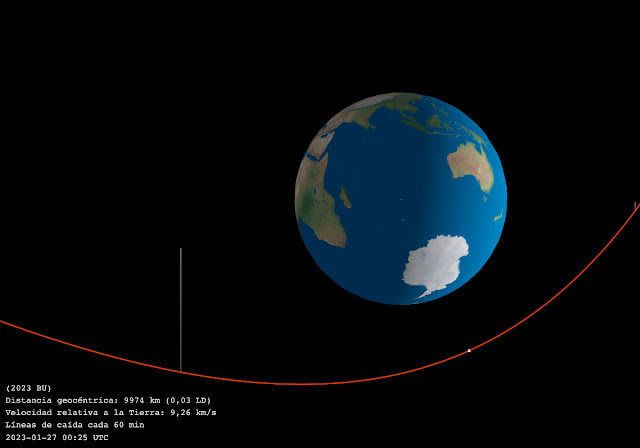The asteroid 2023 BU, which is now traveling toward Earth and will pass incredibly near to it on January 26, was only recently spotted by scientists.
It will be an amazing
view and the chance to see a cosmic rock pass by considerably closer than the
geostationary satellites that are now in orbit.
Using the Crimean Astrophysical Observatory, astronomer Gennadiy
Borisov found the asteroid 2023 BU on January 21. Since the analysis of the
body's orbit indicated a near encounter with Earth, experts have been keeping a
tight check on it.
The tiny body is just 3.8 to 8.4 meters in size, which
implies that if it interacts with the atmosphere, it will ultimately split into
a thousand fragments that will later be burned by friction.
Asteroids are moving at a rate of 9.26 kilometers per
second, according to NASA's Jet Propulsion Laboratory Center for the Study of
Near-Earth Objects. Asteroid 2023 BU is one such object. However, the fact that
the cosmic object will fly by Earth at a distance of fewer than 10,000
kilometers—roughly 25% closer than geostationary satellites put into orbit by
humans—is what truly grabs people's attention.
Asteroid 2023 BU is not thought to be potentially harmful
because of its modest size, according to NASA, despite the fact that it is
quite near to Earth. There is no threat to life on Earth since if it were to
contact with the atmosphere, it would be responsible for pulverizing it.
Asteroids are space rocks that are locked in the
gravitational field of the Sun like planets. Despite being considerably smaller
than planets, asteroids have defined orbits that sometimes intersect Earth. The
asteroid 2023 BU has a 425-day orbit around the main star of the Solar System
and won't come close to Earth again until December 6, 2036, according to the
Center for Near-Earth Object Studies.
Finding the asteroid 2023 BU
Asteroids are often not particularly bright objects to be
seen with the naked eye, in contrast to comets, which get brighter as they go
closer to the Sun and have a dazzling tail. Even though asteroid 2023 BU will
pass near to Earth and its artificial geostationary satellites on January 26,
it won't be seen without a telescope since it will only be 19.15 magnitude at
that distance.
However, individuals who aren't seasoned asteroid hunters
always have choices. The passing of asteroid 2023 BU will be webcast by the
Virtual Telescope Project, situated in Italy, on January 26. The Virtual Telescope
Project will aim straight at the near-Earth asteroid via a live video on its
official YouTube account. The live stream will start at 1:15 p.m. Central
Mexico time.

